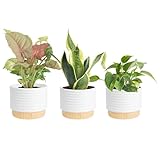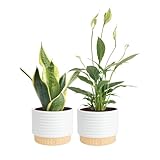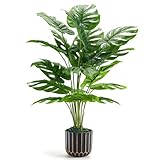Creating a lush indoor garden can transform any space into a tranquil oasis while enhancing air quality and overall well-being. In this comprehensive guide, we will explore the best plants for indoor settings, offering valuable insights and recommendations to help you make informed decisions for your indoor gardening endeavors. Choosing the right plants that thrive in indoor environments is essential for a successful indoor garden, and we are here to provide you with expert reviews and a detailed buying guide to assist you in selecting the perfect botanical companions for your home or office.
Discover the top-rated plants that not only beautify your surroundings but also purify the air, boost productivity, and bring a touch of nature indoors. From low-maintenance succulents to vibrant flowering plants, our reviews cover a diverse range of options to suit every preference and level of gardening expertise. Whether you are a seasoned plant enthusiast or a beginner looking to greenify your indoor spaces, our article on the best plants for indoor cultivation will offer you valuable insights and guidance to create a thriving indoor garden that enhances your living or work environment.
We’ll cover the best plants for indoor later in this article. Meanwhile, feel free to check out these related products on Amazon:
Last update on 2025-11-29 / #Ad / Affiliate links / Images from Amazon Product Advertising API
Growing Greenery Indoors
Plants for indoor spaces are not only aesthetically pleasing but also have numerous benefits for indoor environments. Bringing elements of nature indoors can improve air quality by filtering out toxins and increasing oxygen levels. Additionally, indoor plants have been shown to reduce stress, boost mood, and enhance productivity.
When selecting plants for indoor spaces, consider factors such as lighting conditions, humidity levels, and available space. Low-light plants like snake plants and pothos are ideal for spaces with limited natural light, while ferns and peace lilies thrive in humidity-rich environments like bathrooms.
Caring for indoor plants involves regular watering, proper drainage, and occasional pruning. Understanding the specific needs of each plant, such as watering frequency and fertilization requirements, will ensure they remain healthy and vibrant in indoor settings. Incorporating indoor plants into home or office spaces can not only enhance the visual appeal but also contribute to a healthier and more enjoyable indoor atmosphere.
Best Plants For Indoor – Reviewed
01. Spider Plant
Known for its air-purifying properties, the Spider Plant is a must-have for every household. With its long, narrow leaves and delicate white flowers, this plant adds a touch of elegance to any space. Easy to care for and resilient, it thrives in various light conditions, making it perfect for both novice and experienced plant owners.
Not only does the Spider Plant enhance indoor air quality by absorbing toxins, but its ability to produce ‘babies’ ensures a continuous supply of new plants. Whether as a hanging plant or potted on a shelf, the Spider Plant is a versatile and beneficial addition to any home.
02. Snake Plant
The Snake Plant is a must-have for any household looking to add a touch of greenery to their space without much maintenance. Known for its air-purifying qualities, this plant is not only beautiful but also beneficial for indoor air quality. Its striking long leaves with a deep green hue make it an eye-catching addition to any room.
This plant is low-maintenance, requiring minimal watering and able to thrive in low light conditions. Perfect for beginners or those with a busy lifestyle, the Snake Plant is a versatile and elegant choice for bringing a bit of nature indoors.
03. Pothos
Known for its low maintenance and air-purifying qualities, Pothos is a popular choice for both experienced and novice plant owners. Its heart-shaped, lush green leaves bring a touch of nature indoors, adding a refreshing pop of color to any space. Pothos thrives in various light conditions, making it adaptable to different environments.
This resilient plant is forgiving of irregular watering and can withstand periods of neglect. Its trailing vines can be easily trained to climb or cascade, making it a versatile addition to any room or hanging basket. Pothos is the perfect plant to brighten up your home or office with minimal effort.
Bringing the Outdoors In: Benefits of Indoor Plants
Bringing plants indoors serves as more than just a beautiful aesthetic addition to any living space. One key reason why people need to buy plants for indoor environments is for their air purification qualities. Indoor plants act as natural air purifiers, removing toxins and pollutants from the air and improving overall air quality. This is especially beneficial for individuals who spend a significant amount of time indoors, such as office workers or individuals with respiratory issues.
Furthermore, having plants indoors can also positively impact mental health and well-being. Studies have shown that being surrounded by greenery can reduce stress, boost mood, and increase overall happiness. The presence of indoor plants has been linked to enhanced focus, creativity, and productivity, making them a valuable addition to workspaces and homes alike.
When selecting the best plants for indoor spaces, factors such as lighting conditions, maintenance requirements, and personal preferences should be considered. Some of the best plants for indoor environments include snake plants, pothos, and spider plants, as they are relatively easy to care for and can thrive in indoor settings with minimal effort. By incorporating plants into indoor spaces, individuals can not only enhance the visual appeal of their environment but also enjoy the numerous health and well-being benefits they provide.
Selecting the Perfect Indoor Plants: A Buying Guide
Navigating through the myriad of indoor plants available can be a daunting task. Selecting the perfect indoor plants requires consideration of your space, lighting conditions, care requirements, and personal preferences. Understanding these key factors will help you choose the ideal plants that will thrive and enhance your indoor space.
Light Requirements
Considering the light requirements of indoor plants is crucial for their overall health and growth. Different plants have varying needs when it comes to light exposure, with some requiring bright, direct sunlight while others thrive in low light conditions. Understanding the light levels in your home and matching them to the specific requirements of the plants you intend to bring indoors is key to ensuring they receive the necessary energy for photosynthesis and proper development.
Failing to consider the light requirements of indoor plants can result in stunted growth, yellowing leaves, or poor flowering. Placing a high-light plant in a dimly lit corner or a low-light plant in direct sunlight can stress the plant and lead to negative consequences. By carefully assessing the natural light conditions in different areas of your home and selecting plants that align with these light levels, you can create a healthy and vibrant indoor garden that thrives in its environment.
Watering Needs
Considering the watering needs of indoor plants is crucial in ensuring their health and vitality. Different plant species have varying requirements for water, ranging from frequent watering to more infrequent intervals. Selecting plants that align with your lifestyle and schedule can help prevent overwatering or underwatering, both of which can lead to plant stress or even death. By taking watering needs into account, you can create a more suitable environment for your indoor plants to thrive and flourish.
Space Available
Considering the available space is crucial when selecting indoor plants to ensure they have adequate room to thrive. Different plants have varying growth patterns and space requirements, and overcrowding can lead to poor air circulation and competition for resources. By choosing plants that fit the available space, not only will they have room to spread and grow to their full potential, but it also makes maintenance tasks such as watering, pruning, and re-potting more manageable in the long run.
Plant Care And Maintenance Requirements
Considering the care and maintenance requirements of plants for indoor spaces is crucial for ensuring their health and longevity. Different plants have varying needs for light, water, temperature, and humidity levels. By understanding these requirements before purchasing, individuals can select plants that align with their ability to provide the necessary care. This proactive approach helps to prevent disappointment from plants wilting or failing to thrive due to neglect or improper care practices.
Benefits Of Indoor Plants
Indoor plants offer numerous benefits beyond just adding aesthetic appeal to your living spaces. Firstly, they improve indoor air quality by absorbing carbon dioxide and releasing oxygen, enhancing the overall health and well-being of occupants. Plants also act as natural humidifiers, helping to maintain optimal moisture levels in the air which is particularly beneficial during dry seasons or in air-conditioned environments.
Moreover, indoor plants have been shown to reduce stress and promote a sense of calmness and relaxation. Simply being around plants can have a therapeutic effect on your mental and emotional state, making them ideal for creating a peaceful and tranquil ambiance in your home or office. Studies have shown that caring for plants can also boost mood and productivity, contributing to a healthier and more positive indoor environment.
In addition, some indoor plants are known for their air-purifying properties, efficiently filtering out toxins and pollutants from the air. This can lead to a reduction in symptoms of allergies and respiratory ailments, creating a healthier indoor environment for you and your family. Incorporating indoor plants into your living spaces not only enhances the visual appeal but also contributes to a cleaner, fresher, and more vibrant indoor atmosphere.
Maintenance Tips For Indoor Plants
In order to keep your indoor plants thriving and healthy, regular maintenance is essential. Proper watering is key; ensure your plants have adequate drainage and only water when the top inch of soil is dry. Overwatering can lead to root rot, while underwatering can cause wilting and stunted growth.
Regular pruning and grooming help indoor plants maintain their shape and promote new growth. Remove any dead or yellowing leaves to prevent the spread of disease and enhance the overall appearance of your plants. Dusting the leaves periodically with a damp cloth will also improve their ability to photosynthesize efficiently.
Lastly, monitor the lighting conditions in your home to ensure your plants are receiving adequate sunlight. Rotate your plants regularly to promote even growth and prevent them from leaning towards the light source. Additionally, providing a gentle misting or occasional shower can help indoor plants thrive in a humid environment, especially during dry winter months.
Frequently Asked Questions
What Are The Best Low-Light Plants For Indoor Spaces?
Some of the best low-light plants for indoor spaces include snake plants, pothos, peace lilies, and ZZ plants. These plants are known for their ability to thrive in environments with minimal sunlight. Snake plants are especially hardy and can survive in almost any lighting condition, making them a popular choice for beginners. Pothos and peace lilies are also great options as they can tolerate low light while adding a splash of greenery to your space. ZZ plants are another low-maintenance choice that can thrive in low-light conditions, making them a versatile and attractive option for indoor gardens.
How Do I Care For Succulents And Cacti Indoors?
To care for succulents and cacti indoors, ensure they receive plenty of sunlight by placing them near a sunny window. Water them sparingly, allowing the soil to dry out completely between waterings to prevent root rot. Provide well-draining soil specific to succulents and cacti to prevent waterlogged roots. Avoid overwatering and protect them from drafts and extreme temperatures. Consider rotating the plants occasionally to ensure they receive even sunlight exposure. These low-maintenance plants thrive in drier conditions, making them ideal for indoor environments with minimal upkeep.
Which Indoor Plants Are Safe For Pets And Kids?
Some pet and kid-friendly indoor plants include spider plants, Boston ferns, African violets, and areca palms. These plants are non-toxic and safe to have around curious pets and children. It’s always recommended to research specific plants before bringing them into your home to ensure they are safe for your family members.
What Are Some Air-Purifying Plants For Indoor Environments?
Some air-purifying plants for indoor environments include spider plants, peace lilies, snake plants, pothos, and aloe vera. These plants are known for their ability to remove toxins and improve air quality by absorbing pollutants. Placing these plants strategically throughout your home can help create a healthier indoor environment.
How Can I Prevent Common Indoor Plant Pests And Diseases?
To prevent common indoor plant pests and diseases, ensure proper watering and drainage, provide adequate sunlight and air circulation, regularly inspect plants for signs of pests or diseases, avoid overcrowding plants, clean and disinfect gardening tools, use natural pest control methods like neem oil or insecticidal soap, and quarantine new plants before introducing them to existing ones. Implementing these practices can help keep your plants healthy and thriving.
Conclusion
Incorporating the best plants for indoor spaces can not only enhance the aesthetics of your home but also promote a healthier and more vibrant environment. From the air-purifying qualities of snake plants to the low-maintenance charm of succulents, choosing the right indoor plants can significantly impact your well-being. By selecting plants that suit your lifestyle and space, you can create a sanctuary that fosters relaxation and rejuvenation. Whether you are a seasoned plant enthusiast or a beginner looking to introduce greenery into your home, investing in the best plants for indoor use will undoubtedly elevate your living space.




